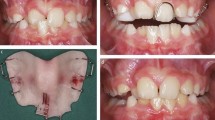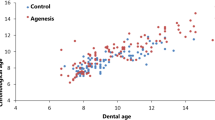Abstract.
The early treatment of nonskeletal and skeletal orthodontic anomalies in the deciduous and early mixed dentition is intended to prevent the development of pronounced anomalies in the late mixed and permanent dentition with the ultimate aim of reducing or even eliminating the need for later orthodontic treatment. There is a general consensus in the international literature that early therapy is indicated in cases of anterior and lateral crossbite and Class III malocclusion, and possibly for extreme forms of mandibular retrognathism (overjet ≥10 mm) and of open bite. However, evidence of the efficiency of early orthodontic measures is just as rare as studies providing serviceable information on the incidence of tooth malalignments and malocclusions in the deciduous and early mixed dentition, some of whose findings are in any case highly divergent. This makes it substantially more difficult to draw conclusions on the extent to which early orthodontic therapy may be indicated.
In order to obtain information on the incidence of nonskeletal and skeletal orthodontic problems constituting a treatment need, 2326 first-year schoolchildren aged between 6 and 7 years were examined in Frankfurt am Main and in the Rural District of Offenbach.
In only 14.7% of the children were no relevant orthodontic findings recorded. 77.2% displayed mild to severe dysgnathic symptoms, though without early orthodontic therapy being considered indicated. Treatment with orthodontic appliances was considered urgent for 187 of the children (8.04%).
With 8.3% and 7.9% respectively, lateral and anterior crossbite were top of the list of anomalies with an urgent treatment need. Among the patients with lateral crossbite, the prognostically less favorable unilateral form was recorded approximately four times more often than the bilateral form. Markedly increased sagittal overjet ≥10 mm) was registered in only 1.4% of the children, and negative overjet (Class III) (with the exception of edge-to-edge bite) in 1.9%. Extreme anterior open bite ≥6 mm) was recorded in only two children (0.09%).
In 19.6% of the children, a supporting zone was reduced in at least one quadrant, necessitating interceptive measures such as the insertion of a space maintainer or later orthodontic treatment (space opening or extraction therapy).
Zusammenfassung.
Frühbehandlungen von Zahnstellungs- und Kieferanomalien im Milch- und frühen Wechselgebiss sollen die Entstehung ausgeprägter Anomalien im späten Wechsel- und bleibenden Gebiss verhindern. Dadurch soll eine spätere kieferorthopädische Behandlung vermieden bzw. im Umfang reduziert werden. Im internationalen Schrifttum besteht weitgehend Konsens, dass eine Frühbehandlung beim frontalen und lateralen Kreuzbiss, bei progenen Formen, ggf. auch bei extremen Formen der Unterkieferrücklage (Frontzahnstufe ≥10 mm) und des offenen Bisses indiziert ist. Nachweise einer Effizienz früher kieferorthopädischer Therapiemaßnahmen sind ebenso selten wie aussagekräftige Untersuchungen über die Häufigkeit von Anomalien im Milch- und frühen Wechselgebiss, deren Resultate zum Teil erheblich voneinander abweichen. Eine Aussage über den möglichen Umfang kieferorthopädischer Frühbehandlungen wird dadurch erheblich erschwert.
Um Informationen über die Häufigkeit behandlungsbedürftiger Zahnstellungs- und Kieferanomalien zu erhalten, wurden in Frankfurt am Main und dem Kreis Offenbach 2 326 Schüler der 1. Klassen im Alter zwischen 6 und 7 Jahren untersucht.
Bei lediglich 14,7% der Kinder lagen keine relevanten kieferorthopädischen Befunde vor. 77,2% wiesen dysgnathe Befunde geringen bis starken Ausmaßes auf, ohne dass jedoch eine Frühbehandlung indiziert erschien. Eine rasche Einleitung apparativer kieferorthopädischer Maßnahmen wurde bei 187 Kindern (= 8,04%) für erforderlich gehalten.
Unter den festgestellten Zahnstellungs- und Kieferanomalien mit großer Behandlungsdringlichkeit dominierten der laterale und der frontale Kreuzbiss mit 8,3% bzw. 7,9%. Bei den Patienten mit seitlichem Kreuzbiss kam die prognostisch ungünstigere unilaterale Form etwa viermal häufiger vor als die bilaterale. Eine deutlich vergrößerte sagittale Frontzahnstufe ≥10 mm) wurde nur bei 1,4% der Kinder, eine umgekehrte (progene) Frontzahnstufe (exkl. Kantenbiss) bei 1,9% registriert. Ein extrem frontal offener Biss ≥6 mm) fand sich nur bei zwei Kindern (0,09%).
Bei 19,6% der untersuchten Erstklässler war in mindestens einem Quadranten bereits eine Stützzone eingebrochen, was interzeptive Maßnahmen wie das Einfügen eines Lückenhalters oder eine spätere kieferorthopädische Therapie (Lückenöffnung oder Extraktionstherapie) erfordert.
Similar content being viewed by others
Author information
Authors and Affiliations
Additional information
Received: September 17, 2002; accepted: February 3, 2003
Correspondence Address Prof. Dr. Peter Schopf, Universitätsklinikum Frankfurt, ZZMK (Haus 29), 60590 Frankfurt am Main, Germany, Phone (+49/69) 6301-5635, Fax -6741, e-mail: schopf@em.uni-frankfurt.de
Rights and permissions
About this article
Cite this article
Schopf, P. Indication for and Frequency of Early Orthodontic Therapy or Interceptive Measures. J Orofac Orthop 64, 186–200 (2003). https://doi.org/10.1007/s00056-003-0234-6
Issue Date:
DOI: https://doi.org/10.1007/s00056-003-0234-6




